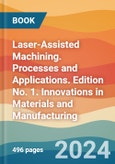This unique book develops exhaustive engineering perceptions of different laser-assisted techniques, reviews the engineering context of different laser fabrication techniques, and describes the application of laser-assisted fabrication techniques.
Lasers are essential in the area of material processing because they can produce coherent beams with little divergence. The fabrication process known as surface cladding includes joining (soldering, welding), material removal (laser-aided drilling, cutting, etc.), deformation (extrusion, bending), and material addition. Some remarkable advantages of laser-assisted material development include faster processing rates and preservation of essential alloying components. However, the lack of widespread understanding of various material phenomena and how laser parameters affect them prevents the technology from being widely accepted on an industrial scale.
Among the subjects Laser-Assisted Machining covers include high-powered lasers in material processing applications, laser-based joining of metallic and non-metallic materials, direct laser cladding, laser surface processing, laser micro and nano processing, emerging laser materials processing techniques, solid-state lasers, laser cutting, drilling and piercing, laser welding, laser bending or forming, laser cleaning, laser automation and in-process sensing, femtosecond laser micromachining, laser-assisted micro-milling/grinding, laser-assisted jet electrochemical micro-machining, laser-assisted water jet micro-machining, hybrid laser-electrochemical micromachining process, quill and nonreciprocal ultrafast laser writing, laser surface engineering, ultrashort pulsed laser surface texturing, laser interference patterning systems, laser interference lithography, laser-guided discharge texturing.
Audience
The book will be used by researchers in the fields of manufacturing technology and materials science as well as engineers and high-level technicians for a better understanding of various innovative and novel techniques to cope with the need of micromachining, as well as microfabrication industries for successful implementation of microproduct manufacturing.
Table of Contents
Preface xxv
Acknowledgments xxix
1 Introduction to Laser-Assisted Machining 1
Sandip Kunar, K. Vijetha, Jagadeesha T., Abhishek Ghosh, S. Rama Sree, Prasenjit Chatterjee, Sreenivasa Reddy Medapati and Nabankur Mandal
2 Laser Welding in Manufacturing Applications 17
P. Sivasankaran
3 Laser-Assisted Machining for Advanced Materials 27
Sandip Kunar, Abhishek Ghosh, Rajesh Kumar, D.V. Janaki, Jagadeesha T., Norfazillah Talib, K.V.S.R. Murthy, Sreenivasa Reddy Medapati and Prasenjit Chatterjee
4 Optimization of Laser Cutting Parameters Using the Taguchi Approach 41
Ranjith Raj A., Senthamarai Kannan C. and Sivaramapandian J.
5 Laser-Assisted Micromilling (LAMM): Process and Applications 53
M. Sivakumar, S. Jayanth, S. Shriram and J. Jerald
6 Removing Algae and Moss Growth on Compressed Stabilized Earth Block Wall Surface by Laser Cleaning 69
Vinod B. R. and K.R. Ashwini
7 A Review of the Effects of Laser Cleaning on the Development of Corrosion and the Removal of Rust in Steel Bridges in Marine Environments 87
Vinod B. R. and Swetha G. A.
8 Laser-Assisted Machining: Its Capability and Future 115
Sandip Kunar, K. Vijetha, Adduri S. S. M. Sitaramamurty, Chanchal Biswas, S. Tripathy, Jagadeesha T. and Sujana Nowshin
9 A Review of the Applications of the Laser Crack Measurement for White Topping Road 129
Vinod B. R. and K.R. Ashwini
10 Characterization of Tensile and Impact Properties of Fabricated AlSi10Mg by Selective Laser Melting Technique 147
Sibabrata Mohanty, Ajit Kumar Senapati, Gopal Krusha Mohanty and Debesh Mishra
11 The Developments and Retrospect of Water-Laser Machining Technology: An Overview 161
Pravin Pawar, Amaresh Kumar and Raj Ballav
12 Laser Welding of Aluminum Alloys 207
Prerona Saha, Abhishek Ghosh, Kalyan Das, Uttam Kumar Murmu, Sandip Kunar and Manojit Ghosh
13 Laser-Assisted Grinding and Milling 227
A. C. Uma Maheshwer Rao
14 Trends in Laser-Assisted Hybrid Machining to Enhance the Performance Quality of Electrical Discharge Machining Process: Opportunities and Challenges 247
S. Tripathy, D.K. Tripathy and S.R. Biswal
15 Laser Welding of Thin Ferrous Sheets with Ferrous and Non-Ferrous Sheets 259
Dhanraj B. Waghmare and Partha Saha
16 Laser Cutting, Drilling, and Piercing 273
Yajush Walia, Roopak Varshney and Param Singh
17 Femtosecond Laser Machining 293
Jagadeesha T. and Sandip Kunar
18 Fundamentals of Laser Welding 315
Jagadeesha T., Sandip Kunar and Prasenjit Chatterjee
19 High-Power Laser in Material Processing Applications 333
Jagadeesha T. and Sandip Kunar
20 Hybrid Laser Electrochemical Micromachining 353
Jagadeesha T. and Sandip Kunar
21 Introduction to Solid-State Lasers 367
Jagadeesha T. and Sandip Kunar
22 Laser Micro- and Nanoprocessing 381
Jagadeesha T., Sandip Kunar and Prasenjit Chatterjee
23 Waterjet-Guided Laser Cutting Technology 401
Jagadeesha T. and Sandip Kunar
24 Fundamentals of Laser Machining 415
Jagadeesha T. and Sandip Kunar
25 Opportunities and Challenges in Laser Bending 435
Omkumar M. and Saravanan R.
26 Laser Cleaning and Its Advancements 447
Omkumar M. and Saravanan R.
References 458
Index 461








